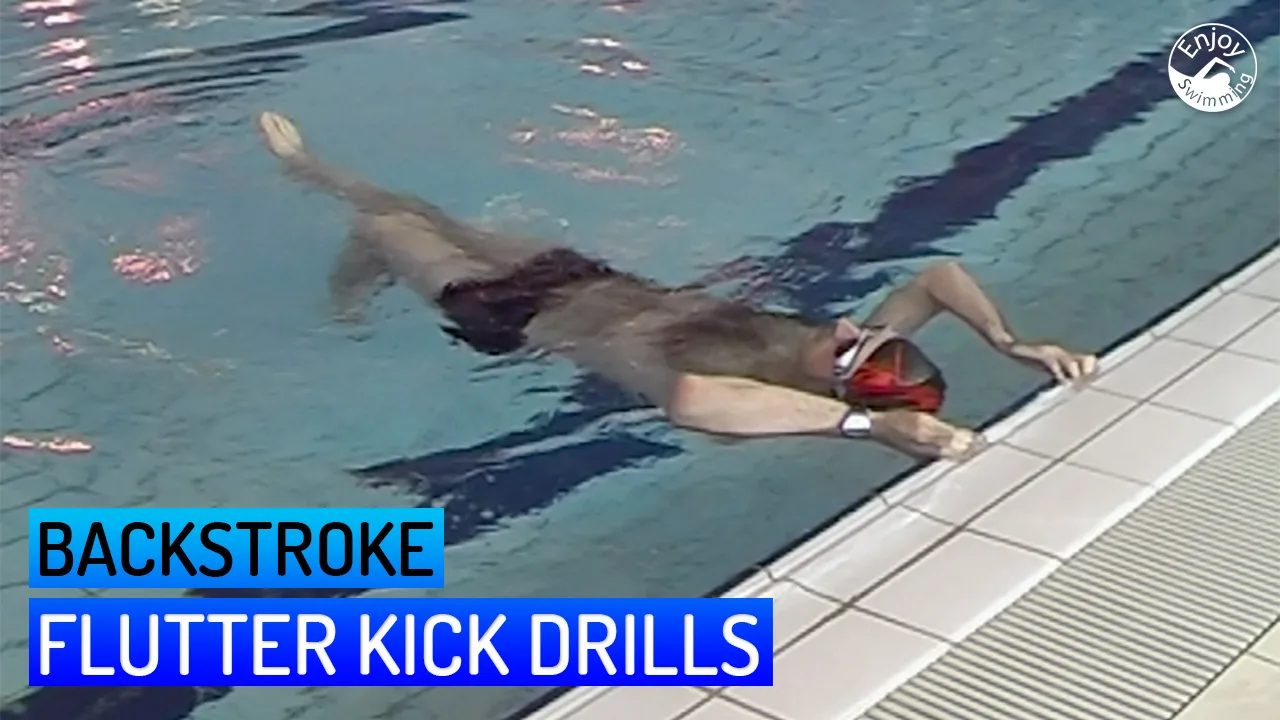The flutter kick is a simple yet efficient swimming technique where you keep your legs parallel and alternatively kick upward and downward with each leg.
The flutter kick is used in the backstroke but also in the front crawl stroke to provide balance and propulsion. See the backstroke kick article for a more detailed description.

Knowing how to do the flutter kick in a supine position (on the back) is an important prerequisite to learn how to swim backstroke.
Video Demonstration
The following video demonstrates a few exercises to practice this technique. Please find additional instructions further below.
Kicking Exercises
The following exercises can be used to learn the flutter kick:
Exercise #1: Go to the shallow area of the pool. Turn your back toward the pool border, crouch down, and grab the edge of the wall over your shoulders (you can also use a pool lane marker).
Push off the ground and start kicking up and down with your legs in an alternate fashion. Your feet should be pointed, and the kicking motion should originate from your hips.
Use the kick to bring your body into a horizontal position. Finally extend your arms, still holding the pool edge, until your body is straight.
Exercise #2: Repeat the previous exercise and try to get balanced to the point where you can hold the edge of the wall with your fingertips. To do this you must have your head, torso, and legs perfectly aligned.
Taking a deep breath to fill your lungs with air before the exercise also helps.
Exercise #3: Repeat the previous exercise, and when you are at the point where you are holding the edge of the wall with your fingertips, just let go. Keep kicking and enjoy the feeling of floating in a perfectly balanced position.
Exercise #4: Turn your back toward the pool, push off, and get into a supine position with your arms extended overhead. Flutter kick. Try to experience the feeling of perfect balance like you did in the previous drill.
Additional Tips
Tip #1: To avoid getting water in your eyes or your nose, use swimming goggles and a nose clip.
Tip #2: If your ankles are stiff, it could be difficult for you to flex your feet away from your body.
In that case, the use of swim fins can help loosen up your ankles, and they will become more flexible over time. Use Zoomers as their short blades will keep the kick similar to a finless kick.
Tip #3: If it is difficult for you to get your arms in front of your head in the last exercise, it could be that your shoulders and chest are stiff and this will impede balance. Regular rotator cuff stretches will loosen things up.
Tip #4: If your hips and legs still drop while kicking, it could be that your upper body is too high in the water.
Try to push your head and chest a little more into the water. The buoyancy of your lungs should then make your legs and hips come up.
Tip #5: Another common mistake is to have an angle between your torso and your legs, which makes the whole body sink. So make sure to get your upper and lower body aligned.
Tip #6: A friend or swim buddy can be of great help to spot mistakes that prevent you from finding good balance.
Learning Path for the Backstroke
Below is an overview of our series of articles on learning the backstroke. Each article in this series contains one or more drills that have to be mastered. The current article is highlighted:
Once you have gone through all the steps of this learning path, you should be able to swim backstroke without any problems.
Good luck!
